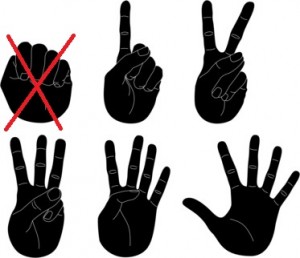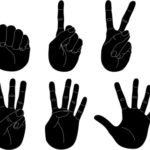Fist of Five Voting is a deceivingly simple process you can use to check-in, learn, gain consensus, and/or vote to understand where people stand on an issue or idea. I say deceivingly, because there is so much more you can learn about what is really happening in a team if you are paying attention.
I find there are many tools I (and others) use without being entirely sure of the idea’s origin. As I work on other articles, I realize some people may not be familiar with concepts such as Fist of Five Voting. So I’m working on building these ideas out to fill in those gaps. The source of Fist of Five is sometimes attributed to American Youth Foundation, however I can’t find a reference on their website.
Fist of Five Voting is a quick way to allow everyone to vote on and gauge a topic, in a range, by holding up a hand with 0, 1, 2, 3, 4, or 5 fingers (read on if the 0 sounds odd to you!).
What is Your Goal?
When using Fist of Five (or any voting method), it is important to know why you are calling a vote. This might sound trivial, but there are a few ways to use Fist of Five — without stating your goal, you can end up with confusion.
- Check-in on where people are in their thinking: You can call a quick vote at any point in a process to get a sense of where the room is on an issue. Imagine a large group working on an issue in breakout groups (release planning, for example). You might have 2 hours planned for a segment, with a check-in after 45 minutes. After the first 45 minutes, you might find that you finished earlier than anticipated and can move on to the next portion of the event. You also might find that you are not making the progress you expected and need to make some changes.
- Learn and gain consensus: Learning and gaining consensus is a key outcome to aim for with Fist of Five and relates to the check-in. You have the option, as you see that some do not agree or that some do not agree as strongly as others, to discuss specific issues and concerns. This allows for a stronger decision to move forward and can uncover issues that strong supporters of an idea perhaps did not consider.
- Vote and move forward without consensus: If your goal is to simply vote and move forward without consensus, the method works for that as well. You simply vote, using the method below, and you have your answer. You might decide to have some level of learning as well, just be clear about how much and when you will take a final vote.
Confusion arises when people assume we are working towards consensus, but are in fact aiming for a winner-takes-all vote without discussion. Even in situations with some discussion, it is important to clearly state how the process will work. Will you have one round of discussion? Two? More? As a facilitator of this process, consider how you will handle potential challenges in the process such as a person blocking consensus. As in any voting, if you ask for a vote, be prepared to abide by it, even if it is not YOUR choice (a note for anyone who asks for a vote and has skin in the game).
Fist of Five Voting Method Steps: Option 1
[A note for many who have used Fist of Five Voting Method: Option 1 may be different from what you have used. Many people do not use a fist, and I will discuss this in Option 2 below. I actually prefer Option 1; I’ll discuss why in a moment].

- State the question: “Is everyone okay with Indian food for dinner?’
- Count: 1, 2, 3, vote! Everyone votes at the same time and hands must be held high. This may seem trivial but, for more contentious topics (although this could be one), it is important that people do not look to others in the room to see how to vote.
- Each person votes by holding up 0, 1, 2, 3, 4, or 5 fingers.
- The facilitator (or vote caller) looks around the room and quickly tallies the votes. The votes breakdown like this:
- 0 fingers (a fist): No way, terrible choice, I will not go along with it. A way to block consensus.
- 1 finger: I have serious reservations with this idea, but I vote to move forward, but I’d prefer to resolve the concerns before supporting it.
- 2 fingers: I have some concerns, but I’ll go along and try it.
- 3 fingers: I will support the idea.
- 4 fingers: I like this idea, sounds good.
- 5 fingers: Absolutely, best idea ever! I’ll champion it.
- Based on the goal of the vote (as noted above), the facilitator takes the next steps…
- Goal: Check-in — The facilitator uses the results to adjust the session, make changes, start a discussion, or other actions based on how the vote went and how he/she sees the process progressing. Was the vote what you expected? Different? Do you believe changes are required?
- Goal: Learn and gain consensus — If you have some 0s, 1s, or 2s, ask for reasons. What reservations do they have? You ask for a brief summary or a bottom-line of the reasons. Ask for other bottom-line comment from others. Then call another vote. You may learn new information to restate the question and vote again.
- Goal: Vote and move forward — If everyone has fingers up, that is a yes. If everyone has a fist up, that is a clear no. If there is a mix, it is a winner take all, number of hands with fists, vs. number of hands with fingers up (1 thru 5).
If you decide you want to learn more about people’s reservations to develop a stronger decision, you can use the ideas from the goal ‘Learn and gain consensus.’ If you choose this, it is important to have a clear plan to move on, and for everyone to understand that you are not aiming for consensus, but instead Deep Democracy (you want all voices to be heard). The learning variation can be a challenge, since the facilitator will at some point have to decide when the vote stands. This can be very hard to do if you do not have an alliance developed with the group (certainly if you are not impartial and were just the one to call the vote). Everyone does not have to think this is the best idea ever, but Fist of Five voting provides a way for people to voice a spectrum of opinions. You may have some people that are willing to support the idea, even with some reservations. The process also airs different ideas and provides a clear way to discuss differences.
Fist of Five Voting Method Steps: Option 2
This option of Fist of Five Voting is similar, but does not use the fist. This is the one I learned first. I like Option 1 better at this point for a few reasons. I like the fist blocking consensus. It is clearer and visually easier to count. I also prefer the broader variation with the fingers and that anyone holding up a finger is on board to vote “yes.”

An alternate option to Fist of Five works in almost the same way, except the the votes have the following meaning:
- 1 finger: No way, terrible choice, I will not go along with it. A way to block consensus. Replaces fist in option 1.
- 2 fingers: I have some concerns, but maybe we can figure out an option. I’d prefer to resolve the concerns before supporting it.
- 3 fingers: I will support the idea, but I’m right in the middle on this one.
- 4 fingers: I like this idea, sounds good.
- 5 fingers: Absolutely, best idea ever! I’ll champion it.
Wrapping It Up: Try it out!
I’d add that with any voting process, it is important to utilize other tools, techniques and ideas to ensure you have a space of respect established. Some ideas include building an alliance with the group, The Responsibility Process, Team Toxins, I Statements, and more!
Using Fist of Five, with respect, is great for teams (or groups) to learn more about an idea as well as each other. Done well, it can be another means to increase collaboration, understanding, and improve the team’s ability to work together!
I know many people have used Fist of Five Voting before, though perhaps not Option 1 using a fist. If you have not, try it and let me know how it works. If you have been using it, let me know what variations you use!











Jake,
This is an amazing write-up.
I use and teach a “1” under Option-1 differently. The way you are using it a “1” means that a person will support a decision.
I use it as a blocking move that is used to help the team explore alternative or better decisions. I define it as “I have serious reservations with this idea: would like to ask a question or propose alternative.”
– Michael
Jake,
Thanks for publishing this. But I am surprised at how you have structured the meaning of 0 / 1 / 2 fingers.
This technique was originally popularized by Jean Tabaka in her book Collaboration Explained, and her coaching while at Rally.
See:
https://books.google.com/books?id=2t4gicEZLYQC&pg=PT128&lpg=PT128&dq=Janet+Danforth+fist+of+five&source=bl&ots=dKVAgrHLD3&sig=71mAjqBbX96GXQBOnMkQ7qb91h8&hl=en&sa=X&ved=0ahUKEwjFgJj345TZAhVRs1kKHSceC_oQ6AEINTAF#v=onepage&q=Janet%20Danforth%20fist%20of%20five&f=false
It is important that 1 AND 2 are blocking votes. First, it offers an indication of the degree of opposition. Second, having 2 options offers some more safety – you can still block without being intensely negative (some people might be reluctant to throw a 1 in any case).
Otherwise, thanks for continuing to popularize this awesome technique.
Michael, yes, there are two versions out there. The the one and two as the lowest or the fist and one as the lowest. Whatever one you prefer is the best one for you! I would agree that discussing any of the lowest two votes is critical. Did not mean to imply otherwise. In larger groups, I have found that the fist and one are easier to see, visibly, as I noted, whichever works for you. I’ve went back and forth as I said. Thanks for the comment and link to Jean’s book!
If the goal is to build consensus, but then at the end, the final choice and decision is made by the boss, principal, captain, or a person in charge, what is the purpose of building consensus, if he/she already has their own set agenda?
Shawn, if they already what they will do – why not just say that. It makes zero sense to ask people and then “overrule” them. If you want input, fine – then say “I want input, then I will decide”. But don’t say you others can vote and then do whatever you want – at least don’t do that if you want people to engage.